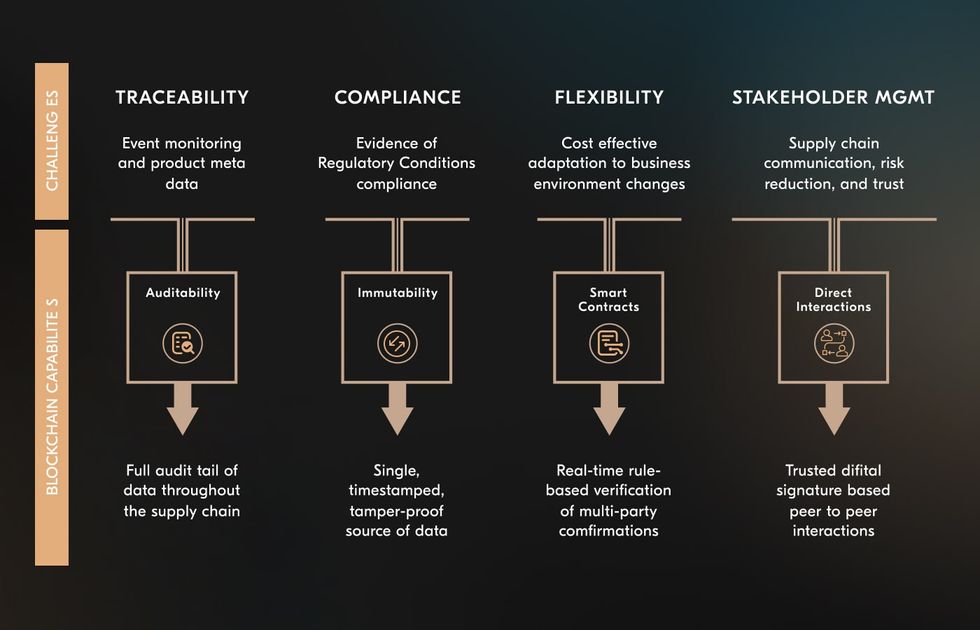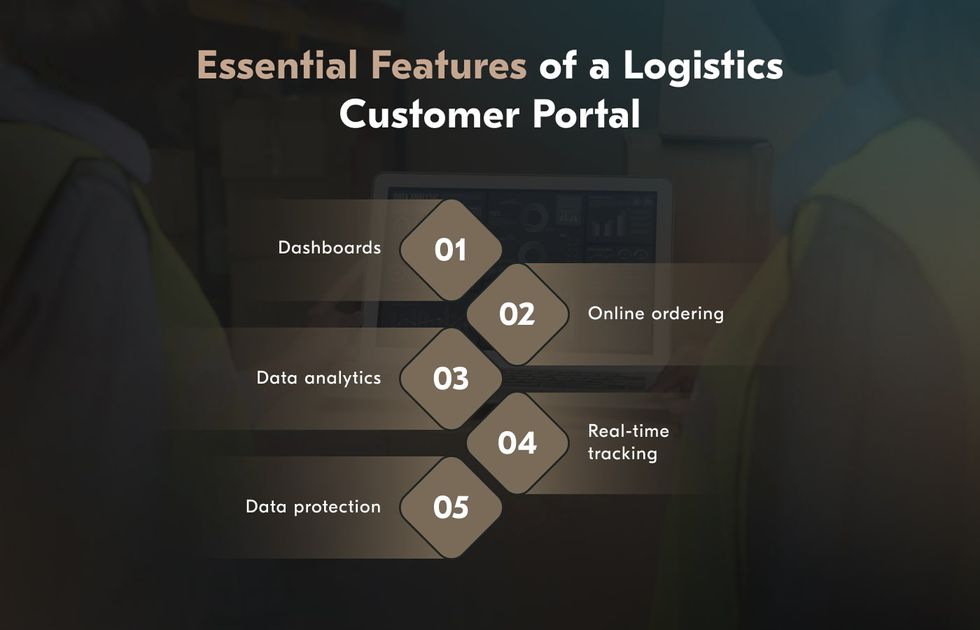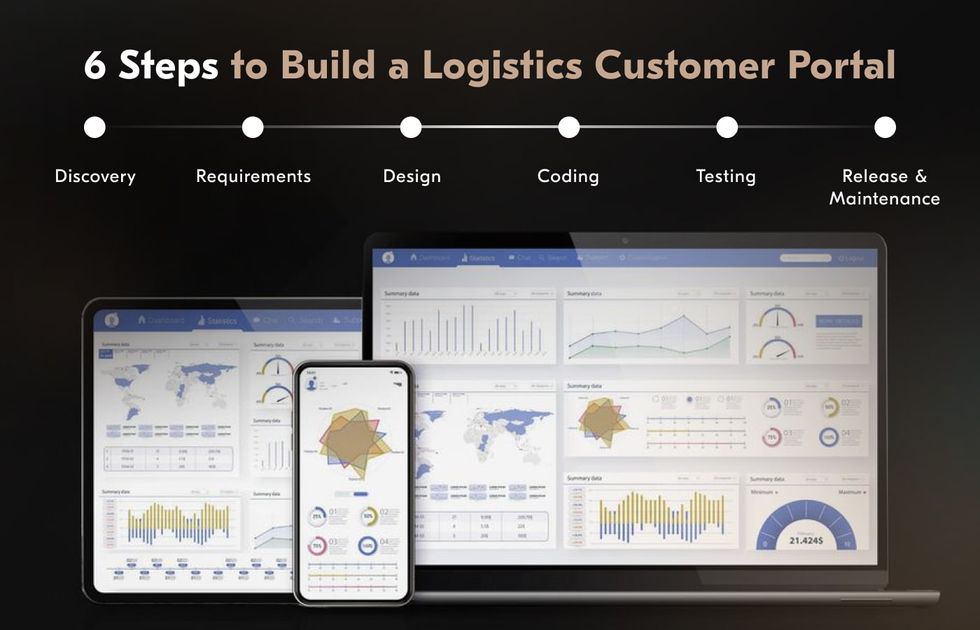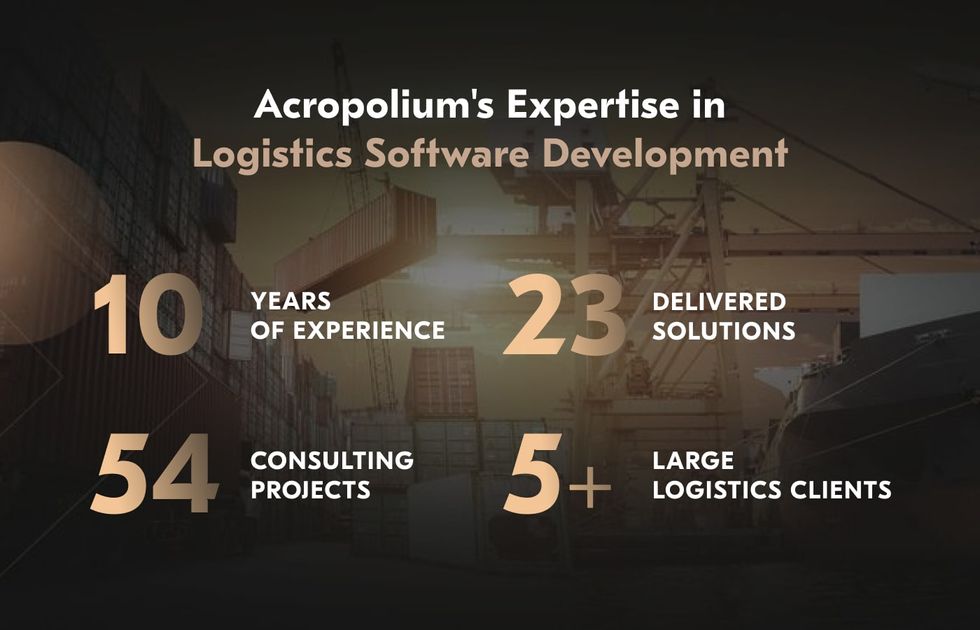
Key Takeaways
- A well-designed logistics customer portal simplifies shipment tracking, order management, and communication, creating a seamless user experience.
- The logistics software market is set to grow from $10.75B in 2023 to $19.7B by 2030, with a 9.03% CAGR, driving demand for tools like logistics customer portals.
- Real-time updates on shipments, storage conditions, and vehicle statuses increase operational visibility and customer trust.
- Empowering users to handle routine tasks independently fosters satisfaction and reduces reliance on customer support.
Customer web portals have become the norm for the logistics and transportation industries. Client portals bring much-needed transparency to the table, improve user satisfaction, and automate ordering.
A feature-rich web portal allows companies to track shipments, identify the fastest routes, plan deliveries, and cut operational costs. But how can you develop a customer portal that helps improve logistics performance?
With Acropolium’s logistics software development services, businesses can optimize the ineffective aspects of their businesses to make them more cost-effective. Based on our expert insights, let’s explore the nature, benefits and use cases of logistics customer web portals.
Why build a customer portal for logistics businesses?

A logistics customer portal is a self-service shipping web platform that allows clients to seamlessly access and manage critical order and shipment information. Unlike traditional tools, these portals provide much more than just shipment tracking.
The logistics software market is on the rise, growing from $10.75 billion in 2023 to $11.67 billion in 2024, with a projected CAGR of 9.03%. By 2030, it’s set to hit $19.7 billion—highlighting the growing demand for tools like logistics customer portals.
The primary goal of such logistics apps is to enhance the overall customer experience. Based on the customer, the information can include:
- Invoices
- Insurance policies
- Order and quote management
- Return merchandise authorization
- Vehicle tracking
- Feedback from customs
- Carrier’s and vendor’s track records
- In-depth reports with pictures
A key objective of a client’s portal is to improve the customer experience. And the customers for a logistics company usually are:
- Wholesalers and retailers (especially in the agricultural and food sector), who rely on logistics to connect their products with consumers
- Independent contractors and transportation companies who transport goods for other logistics companies
- Third-party logistics companies (3PLs) that use third-party carriers, warehouse managers, and vehicles to distribute goods
Each customer type has unique priorities: wholesalers focus on detailed shipment tracking, independent carriers prioritize vendor reliability and licensing, and 3PLs aim to cut transportation costs and minimize risks.
How can you make all these clients happier? Develop an online customer portal for the transportation business — be it ocean, ground, rail, or air vehicle management. Below are some of the benefits of a sophisticated self-service platform.
The benefits of customer portals in logistics

A well-designed portal for customer service in supply chain business enhances operational visibility while simplifying complex workflows. Let’s dive into the key features such a portal offers, beginning with real-time tracking and transparency.
Real-Time tracking and transparency
Transparency is a cornerstone for many industries, especially retail. By investing in a customer service portal development for a supply chain business, you can get an app that provides information about every step of shipping:
- Acceptance and delivery of goods
- Real-time tracking information
- Last-mile delivery optimization
- Warehouses that store the cargo
- The temperature in the storage area (in warehouses and vehicles)
- Information about the transporting vehicle and its driver
- Detailed reports (sometimes with photo or video evidence)
- Document packages (including scans, images, and tracking codes)
Additionally, during the shipping process, carriers can use telematics-powered mobile apps to connect with the customer portal on the go. This feature allows them to see important events (notifications), communicate with vendors securely, update shipment status, submit invoices, and upload scans.
Streamlined order management
A logistics customer portal smoothens out order-related processes by automating tasks such as order placement, status tracking, and invoice generation. It reduces human error, accelerates workflows, and ensures that all stakeholders have access to real-time updates.
Improved communication and collaboration
Acting as a centralized communication hub, the portal fosters seamless collaboration among carriers, vendors, and customers. Live messaging, shared dashboards, and automated notifications ensure everyone stays aligned. Such a functionality minimizes misunderstandings, improves coordination, and helps resolve issues swiftly.
Customized self-service options
With self-service capabilities, users can track shipments, access reports, update preferences, and manage returns without external assistance. When you empower clients to handle routine tasks independently, the portal enhances the user experience, reducing the need for customer support.
Enhanced decision-making with smart analytics
Advanced analytics tools within the portal leverage data from IoT devices, historical records, and predictive algorithms to provide actionable big-data insights. You can optimize driving routes, connect maps through APIs, forecast demand, and proactively address disruptions. Eventually, this will positively impact operational expenses.
Ways to improve logistics performance with a customer portal
A well-functioning web portal can help improve revenue and optimize logistics processes. How? Here are some strategies.
Invest in blockchain for shipping optimization

We’ve mentioned transparency on more than one occasion. Blockchain-powered software makes the business a whole lot more visible. According to a 2023 report by the Council of Supply Chain Management Professionals (CSCMP), more than 80% of logistics firms identified enhancing supply chain visibility as a top priority.
Creating a customer portal in logistics with blockchain technologies can make many processes safer. For example, secure contracts can keep the logistics company closer to the manufacturer, making most counterfeiting attempts unsuccessful.
Cost-efficiency is another factor. Wholesale, 3PLs, storage facilities, and carriers will benefit from smart contracts — secure peer-to-peer payments you can conduct without paying banks or other intermediaries.
Implement IoT into the customer portal
Internet of Things (IoT) refers to a system of computing devices (trackers, sensors, and communications software) that automatically connect and process data.
When data from IoT devices is integrated into the customer portal, a company can monitor various aspects of the shipping process, such as:
- Products. Are you delivering perishable items, such as food or medicine? You can get immediate alerts if the temperature in the containers deviates from the required levels.
- Assets. Customers can see any vehicle’s status and plan when to send them for a service without disrupting the supply chain.
- Carriers. Logistics companies can send messages to drivers or modify routes in real-time, resulting in more effective change management.
For example, companies delivering perishable goods can receive immediate alerts if container temperatures deviate from required levels, ensuring product quality. Customers can monitor vehicle statuses, allowing for proactive maintenance scheduling without disrupting the supply chain.
Logistics companies can communicate with drivers and modify routes in real-time, enhancing change management and overall efficiency.
Take advantage of automated data analysis
Spreadsheets won’t be enough to analyze vast amounts of data. If you want to make the most of IoT and Big Data in logistics, you need to invest in automated data analysis. According to the Ctrlchain report, 90% of business leaders say real-time operational data is critical for decisions and competitive edge. Yet many transport planners still use Excel.
In fact, digital transformation boosts safety and compliance by 50% and increases revenue and profit by 43%. Thus, machine learning can help you turn raw data into actionable information, thanks to which you can:
- Create more efficient routes to avoid late shipments
- Plan assets and inventory based on the customer demand
- Improve the efficiency of transportation management systems (TMS) by predicting cargo disruptions and proactive shipment management
Additionally, machine learning predicts delays from weather, traffic, or equipment issues, enabling proactive rerouting and resource allocation. Integrating predictive analytics into portals gives clients insights to streamline operations and boost supply chain efficiency.
Such analytics, in turn, improve transportation management systems by anticipating cargo disruptions and facilitating proactive shipment management.
Focus on the customer’s needs
Prioritizing core features in a self-service portal, such as real-time shipment tracking, personalized dashboards, and seamless communication channels, enhances user experience and satisfaction. If you really understand your user needs and address specific customer needs, you can develop portals that foster stronger client relationships and drive growth.
What are these features? Keep reading to find out.
Key features to include in custom logistics customer portal software

Now, what components do your customers want to see in an online portal? Let’s have a look.
Dashboards
The dashboard lets users see essential information about shipments at a glance. Simplicity is the fundamental element here, meaning you shouldn’t clutter the screen with information blocks.
Display only the crucial data for the main screen, such as the tracking history for the last shipments and recent notifications. The user should be able to quickly navigate to other sections of the portal for specific information and reports.
Example:
- Project44 allows shippers and 3PLs to automate processes and improve their delivery services while providing vital data on an intuitive dashboard.
Invoice & billing management
Your customers will want to view, submit, and approve standard documents. At the very least, your self-service portal should allow companies to manage:
- Invoices
- Receipts
- Bills of lading
You also need to consider the ability to add custom templates. This will allow your customers to maintain a steady document flow from your portal.
Example:
- Spire is a successful company with self-service tools for online payment, paperless billing, and invoicing.
Online ordering
Your customers should be able to create orders themselves without talking to logistics managers. Moreover, the process should be convenient. Clients will look elsewhere if they have to fill in tons of unnecessary fields for every order.
A few tips to make ordering as fast as possible:
- Implement an auto-fill feature
- Allow users to edit templates
- Make it possible to load shipment info from files
- Offer a user-friendly chatbot that will cover the most common inquiries fast
We recommend letting users choose the type of shipment and delivery item category first. After all, the number of fields will vary depending on the required services.
Example:
- Amazon Logistics is a prime example of a user-friendly web platform where customers can quickly order deliveries.
Data analytics
Big data analytics and reporting are necessary for improving business performance. This feature can provide users with logistics metrics, giving them insights into the money and time spent on shipping, successful deliveries, cargo weights, and customer satisfaction. You can even add ratings for different companies and contractors.
Example:
- OOCL Logistics offers a dedicated customer portal for storing reports or photos and convenient data exchange between vendors.
Real-time tracking
Perhaps the most sought-after feature in the logistics business. With efficient GPS tracking software, your customers will know the exact position of their shipments. This can allow them to plan routes, adjust delivery dates, and react to unforeseen circumstances. It’s essential to establish a constant link between your trackers, software, and customer portal. This can create potential security concerns, but you can overcome these if you outsource your logistics customer portal software development to an experienced company.
Example:
- DispatchTrack is a delivery portal with an innovative logistics tool that allows users to track orders in real-time.
Data protection
Cybersecurity is not so much a feature as a necessity for web portals. The reason is quite simple — hackers could access sensitive personal, payment, and employee data for your portal. They can even use it to track shipments.
Some of the best practices you can use to safeguard your portal include:
- HTTPS protection for your web portal
- Tokenization features
- Role-based access control
- Reduced log-in sessions
- One-time passwords and adaptive authentication
- Carrier authentication for each real-time tracking request
The most effective solution is DevSecOps — a methodology that integrates cybersecurity into software development from the start. The right software development company can build a highly secure customer portal with robust security features to protect your business data.
How to build a customer portal for logistics in 6 steps

We’re telling you upfront: creating a customer portal for your logistics business will be difficult, expensive, and time-consuming. We’ll break it down for you in six steps for easier understanding.
Step 1: Discovery
Successful development starts with research. This stage includes:
- Identifying the target audience
- Competitor analysis
- Defining business objectives
Make sure that you know your target audience and their core needs before crafting a logistics portal. With this in mind, and after researching your competitors, you’ll be ready to consider your key goals.
Step 2: Requirements gathering
Next, your team should gather requirements and define specifications for the product. This includes the technology stack, the project’s budget, and time estimates. At the end of this stage, companies usually create a development plan with a detailed technical description.
Step 3: Design
The design stage involves the creation of a portal’s layouts, sitemap, and interface elements. You have to make the portal visually appealing for the target audience (which can be pretty wide for logistics businesses). Therefore, your team should be serious about color selection, icons, and interactive elements.
Step 4: Coding
Coding is the central stage of the development process, during which your team should first create a Minimum Viable Product (MVP) of your web portal. For faster development, you can try a low-code approach. It will give you a glimpse into the essential features of the client’s portal and allow you to calculate the total development time and budget.
After approving a prototype, your development team will have to proceed according to the technical specifications and project architecture.
Step 5: Testing
Testing happens throughout the development (unit testing) and before the launch (integration testing). The goal is to make sure all services and technical features work correctly. Additionally, your team needs to verify the web interface and mobile apps work with other plugins and third-party systems your customers rely on. And, most importantly, the web portal should have strong cybersecurity to prevent data breaches.
Step 6: Release and maintenance
Many companies think their work is done after the release. But that’s not entirely true. The release is only the beginning. Web portals have a very high usability level, and you always need to be ready to fix bugs, improve functionality, or add new features, so make sure to work with reliable web or SaaS developers.
Our way to create a logistics customer portal software

With over 10 years of experience, 23 delivered solutions, and trusted partnerships with five major logistics clients, Acropolium knows logistics. Our expertise lies in creating innovative, scalable systems tailored to modern business challenges to enter the market fast.
Case Study: Smarter Trucking Dispatch
A logistics client struggled with inefficiencies caused by outdated systems and manual dispatching, leading to rising costs and missed deadlines. Acropolium developed a SaaS dispatch platform with:
- Smart route planning powered by real-time traffic and weather data.
- Centralized fleet management for live updates and performance tracking.
- AI analytics to predict demand and optimize cloud resources.
- Customer tools for delivery estimates and automated updates.
Results
- 15% lower fuel costs
- 20% faster deliveries
- 30% more on-time shipments
The bottom line
A web portal is so much more than a self-service substitute for customer support. With the right technology trends and innovative software employed, it can become a powerful business tool that gives companies a competitive edge.
By leveraging IoT, blockchain, and AI, businesses can optimize operations and gain a competitive edge. With over 10 years of experience, Acropolium is the ideal partner for your digital transformation. Offering subscription-based cooperation, we are here to ensure flexibility and long-term support.
Let’s build a custom, scalable logistics customer portal that drives growth and meets your business needs!









![Machine Learning in Logistics and Supply Chain [7 Use Cases Included]](/img/articles/machine-learning-in-supply-chain-and-logistics/img01.jpg)
![ᐉ Uber API Integration: [Step-by-Step Guide & Use Cases]](/img/articles/how-to-integrate-uber-api/img01.jpg)

![Transport App Development [A 2025 Guide for Startups & Businesses]](/img/articles/transportation-app-development-guide/img01.jpg)

![How to choose the Best Transportation Management Software [2025 Guide]](/img/articles/best-transportation-management-software/img01.jpg)